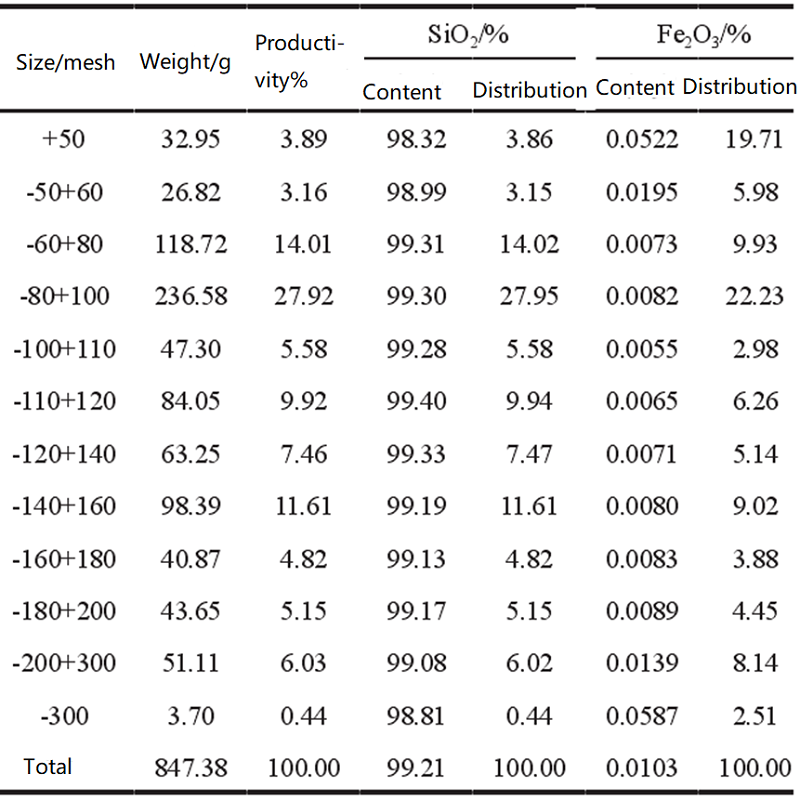Sinonine studied a
sand washing plant, which used quartz sandstone as raw material to produce quartz sand by grinding and washing with water. Under the microscope, the main composition of quartzite is quartz > 95%, and a small amount of impurity minerals. The grain size of quartz is about 0.2-0.5mm, showing a typical trilateral mosaic granular meta crystalline structure. The impurity minerals are mostly located between the quartz grains, and the size is less than 0.1mm.
There are many forms of iron in quartzite, such as dolomite, pyrite and iron oxide. Because of the high content of Muscovite in the sample, the proportion of iron content is relatively large.
In addition, according to the analysis of the magnetic properties of the impurity particles in the sorted quartz sand, it is concluded that the iron oxide in the quartz sand is mainly magnetite.
Grain size distribution of quartz sand
The quartz sand is screened, and the screening results are shown in Table 1.
Table1

It can be seen from table 1 that the grain size of
quartz sand is mainly distributed between -60 to +180 mesh, accounting for 82.33%, the content of SiO2 is relatively high (more than 99%), the content of impurities is relatively low, and the content of Fe2O3 is less than 0.01%. The content of SiO2 is relatively low (less than 99%) and the content of impurities is relatively high, among which Fe2O3 content is higher than 0.01%. In quartz sand -80 to +100 mesh particles are the most, accounting for 27.92% The distribution rate of Fe2O3 in +50 mesh and -80 to +100 mesh quartz sand is the highest, 19.71% and 22.23% respectively.
Impurity content in quartz sand
In order to determine the content of common impurities in quartz sand, ICP analysis was carried out on - 200 + 300 mesh quartz sand and - 300 mesh quartz sand respectively. The statistical results are shown in Table 2.
Table 2

It can be seen from table 2 that the main impurity in the two quartz sand samples is A12O3, but the total content of impurities in the two samples is quite different. The total content of impurities in - 200 to +300 mesh quartz sand samples is 0.29%, and that in -300 mesh quartz sand samples is 1.17%. The content of Fe2O3 in -300 mesh quartz sand is three times of that in – 200 to +300 mesh quartz sand. It shows that the smaller the particle size is, the higher the impurity content is. This is also the reason why quartz sand should be deslimed by stages before beneficiation and purification.
Relationship between iron content and grain size of quartz sand

According to figure 1, Fe2O3 content in -60 to +180 quartz sand is the lowest, with an average value of 0.0075%, and an average SiO2 content of 99.28%, but on the whole, the content of Fe2O3 and SiO2 does not change with the particle size.
The content of Fe2O3 in quartz sand with particle size greater than 60mesh increases with the increase of particle size, and the content of SiO2 decreases with the increase of particle size. Among them, Fe2O3 content in +50 mesh quartz sand is the highest and the SiO2 lowest content is 98.32%.
The content of Fe2O3 in quartz sand with particle size less than 180mesh increases with the decrease of particle size, and SiO2 content decreases with the decrease of particle size. The iron content of -300 mesh quartz sand is the highest and the SiO2 lowest content is 98.81%.
Therefore, the change rule of iron content with grain size is that the larger the grain size (greater than 60 mesh) or the smaller (less than 180 mesh), the higher the iron content.
This is because the large grain quartz sand, especially the +50 mesh quartz sand, has not completely dissociated from the iron containing impurities. The size of iron bearing minerals is generally less than 0.01mm, when the quartz is crushed to -50 μm, most of the iron bearing minerals in the impurity phase of quartz fall off and enter into the -300 mesh quartz sand, which leads to the high iron content of -300 mesh quartz sand. Most of the iron bearing minerals in the quartz sand of -60 + 180 mesh have been separated during grinding, so the iron content is low.
Conclusion
According to the distribution law of iron impurities in quartz sand, in order to improve the quality of products and reduce the content of impurities in quartz sand, especially the content of iron impurities, the grain size of quartz sand should be strictly controlled between -60 to +180 mesh. In addition, in order to improve the efficiency of iron removal, the magnetic separation of quartz sand with particle size of more than 60 mesh and less than 180 mesh is strengthened, which can effectively reduce the content of iron impurities in quartz sand.
For information about high purity silica sand processing, please visit Sinonine Website https://www.9ilica.com , or directly us directly by +86-18118821087(Whatsapp).




